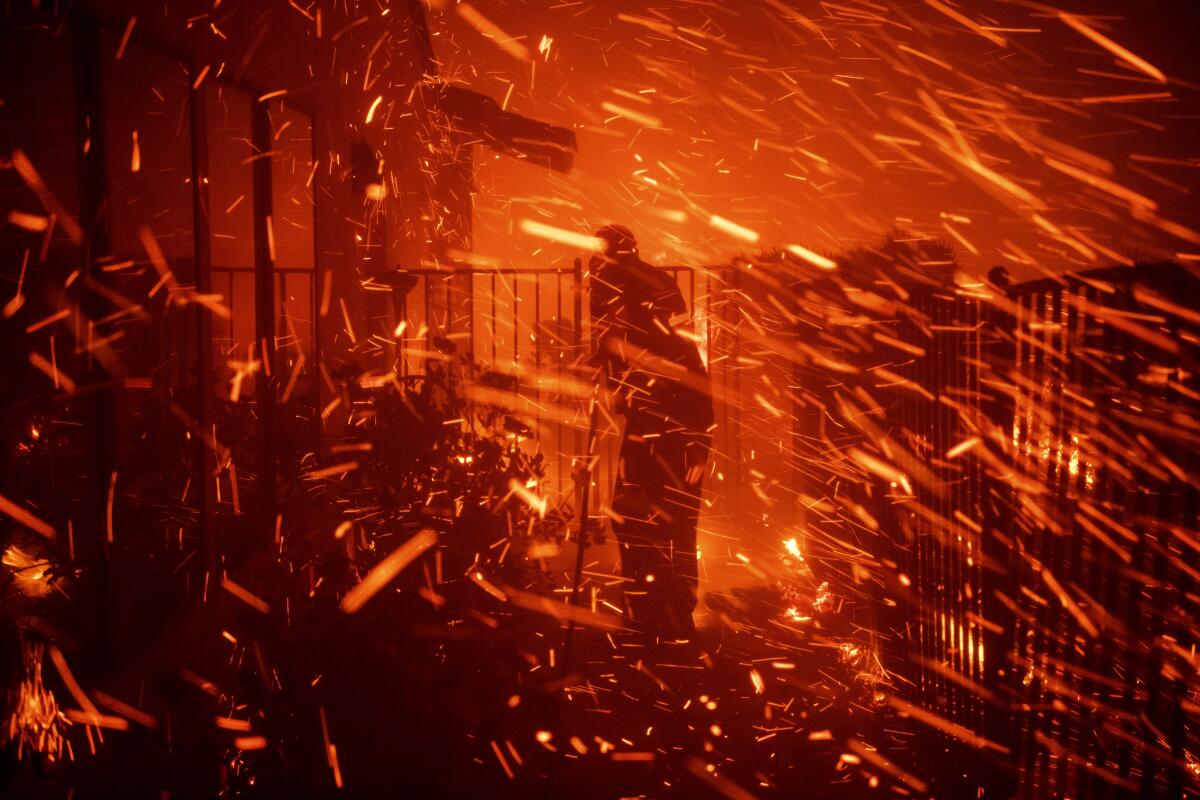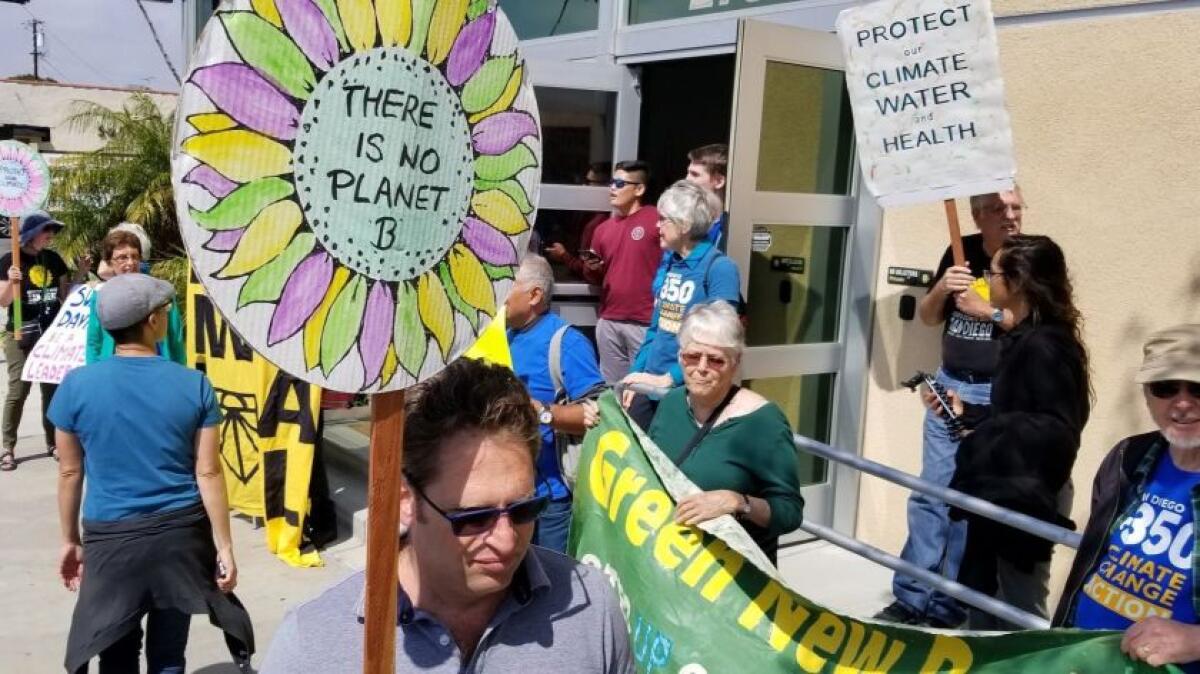UC San Diego, a leader in climate research, under pressure to slash its greenhouse gases
- Share via
LA JOLLA — Bigger wildfires. Stronger storms. Longer droughts.
For years, UC San Diego has been out front in forecasting the impact of climate change, earning the school international praise.
But the campus also is hearing a blunt new message: Do more to help fix the problem. Start by slashing the 300,000 tons of carbon dioxide UCSD puts into the air each year. And act quickly.
The message comes from a UCSD faculty task force which is proposing changes that could affect everything from how the school generates energy and the courses it offers to how often faculty can travel and the foods students are offered in campus dining halls.
“Climate change is an existential threat to life on earth,” said Adam Aron, a psychology professor who co-chaired the faculty Task Force on the Climate Crisis. “Not in 2100, but in the next few decades.
“UC San Diego is in a fantastic position, given its expertise, to lead the way. We need a new campus ethos for dealing with the climate crisis, one that puts emissions reduction into the fabric of every operation.”
The report also says the school should be more aggressive than the University of California system, which is trying to make its campuses carbon neutral by 2025.

That means that campuses would remove as much carbon dioxide from the atmosphere as they put in. However, the schools could pay people and companies to do a lot of the cutting elsewhere in a program called carbon offsets.
The task force says the UC plan is “inadequate” and based on some “dubious” ideas, leading the group to propose dozens of its own recommendations for shaving and slashing carbon emissions at UCSD.
The recommendations are wide-ranging — from ones that are expensive and complex to those that comparatively easy and cheap — although far from being fully fleshed out:
• Replace the school’s $30-million cogeneration plant with a cleaner, more efficient generating system. It’s now mainly run with fossil fuels. Campus officials say major changes can’t be made until after 2032, when the plant’s debt service is paid off.
• Compel faculty, staff and students to fly less often, and apply a carbon mitigation fee to airline flights that involve campus business. Nearly 30,000 people took such flights in 2018, collectively flying more than 38 million miles.
• Make public transportation free for UCSD faculty, staff and students, while incentivizing carpooling and bus use.
• Work with the Metropolitan Transit System to create express bus service to and from neighborhoods that are filled with university workers. UCSD is one of the county’s largest employers.

• Develop mortgage packages that encourage campus members to live close to trolley and bus lines.
• Make most campus vehicles all-electric by 2025. Just over one-third of the existing 1,053 vehicles run on fossil fuels.
• Make vegetarian meals the default choice in campus dining rooms, edging the school away from meat selections, some which involve environmentally unfriendly agricultural techniques.
• Make UCSD deans and vice chancellors personally responsible for meeting emission reduction targets.
• Require the campus to stop taking donations from the fossil-fuel industry.
• Make UCSD withdraw all of its money from Bank of America because the company invests heavily in fossil-fuel projects.
The last two recommendations are likely to be controversial. Historically, many faculty have used donations and grants from the energy and automotive industries to help underwrite their research.
The task force was created in October by UCSD’s Academic Senate, which is responsible for everything from approving courses and setting admission requirements to offering advice on the budget and tending to the welfare of students.
The report was delivered in February and is now being reviewed by the full Senate. Chancellor Pradeep Khosla said he’ll withhold comment until the review is complete.
Some of the material in the report will seem familiar.
UCLA already charges a carbon mitigation fee on business-related airline tickets. And the UC system took on the financial industry in September when it announced that it is getting rid of the fossil fuel investments it has in its endowment and pension funds.
But the report also represents change at UCSD. The school wants to customize and expand its own efforts to curb carbon emissions, which would be a natural extension of the acclaimed climate research that has come out of La Jolla.
That work began in the 1950s under Roger Revelle, who was then director of the Scripps Institution of Oceanography. He organized and led some of the first major studies of the world’s climate. Revelle’s work was so insightful he later become known as the “grandfather of the greenhouse effect.”
He hired such researchers as Charles David Keeling, who began measuring the amount of carbon dioxide in the atmosphere. Over time, the monitoring showed that CO2 was steadily increasing. The so-called “Keeling Curve” data helped scientists establish that the human use of fossil fuels was helping to warm the planet, and that it could lead to such consequences as a global rise in sea-level.
Revelle further placed La Jolla at the forefront of climate change research in 1960 when he co-founded UCSD, which absorbed Scripps, creating an academic powerhouse.
During the ensuing years, UCSD has become a leader in determining how climate change could affect everything from the frequency and intensity of wildfires and damaging storms in California to how rapidly glaciers are melting at the world’s poles. The research is being applied locally: UCSD is helping low-lying Imperial Beach to prepare for rising seas, for instance.
The achievements are a source of pride at UCSD, but they don’t necessarily mean that the university will quickly move on the task force report.
“We’re really on the knife’s edge as to whether things will go any further than this document,” said Cathy Gere, a UCSD history professor. “I think there’s some energy and motivation to do more. But this is a notoriously apoliticalcampus.”
Students say the university’s heavy focus on STEM subjects, and the grueling pace of the 10-week academic quarters, leaves little time for political activism.
Jacob Sutherland, news editor of The Guardian, a campus newspaper, agrees, saying, “You usually don’t see political movements start at UCSD. When they happen, they’re usually part of some larger thing.”
He pointed to a climate rally that occurred on campus in September. It drew about 500 people. But it was part of a global environmental event. Such rallies are rare at UCSD.
Getting the university to shift attention to a major climate initiative also could be tough.
UCSD is spending much of its time, energy and money on a multibillion-dollar expansion. During the past decade, enrollment soared by more than 11,000 and now stands at about 39,000. It could add another 2,000 over the next few years.
Roughly 15,000 students live on campus — a figure that’s expected to nearly double by 2028, when UCSD is projected to become the largest residential campus in the U.S.
The school is raising record amounts of donations and research grants to help fuel the expansion. But UCSD has no immediate plans for projects such as replacing its cogeneration plant.
“The budget is tight. Every dollar is spoken for,” said Eric Halgren, a UCSD neurophysiologist who also is a environmental activist.
“But we also have to avoid going over a cliff due to climate change. And this (task force) report will help us establish goals.”
Halgren also said the fact that UCSD is heavily involved in STEM “means that our undergraduates understand what’s going on with climate change. We could take a leadership position on this issue.”
Robbins writes for the San Diego Union-Tribune.







